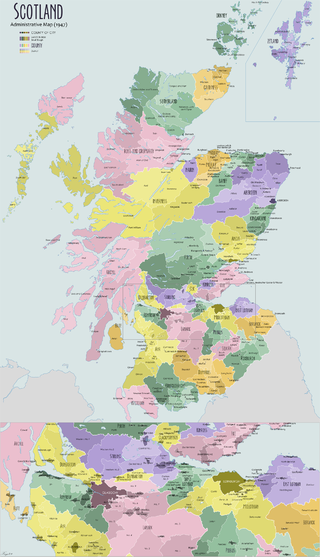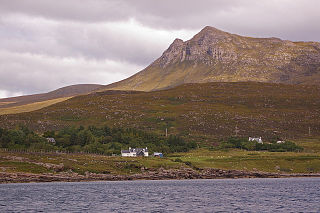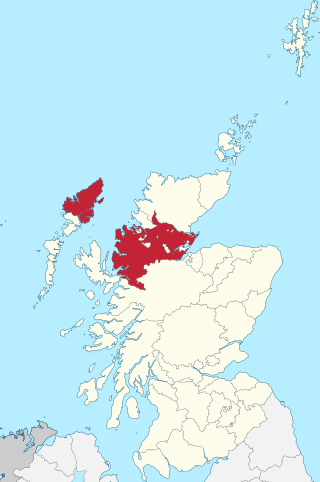
Cromartyshire was a county in the Highlands of Scotland, comprising the medieval "old shire" around the county town of Cromarty and 22 enclaves and exclaves transferred from Ross-shire in the late 17th century. The largest part, six times the size of the old shire, was Coigach, containing Ullapool and the area north-west of it. In 1889, Cromartyshire was merged with Ross-shire to become a new county called Ross and Cromarty, which in 1975 was merged into the new council area of Highland.

The Shires of Scotland, or Counties of Scotland, were historic subdivisions of Scotland.

Ross and Cromarty, is an area in the Highlands and Islands of Scotland. In modern usage, it is a registration county and a lieutenancy area. Between 1889 and 1975 it was a county.

Earl of Cromartie is a title that has been created twice, both for members of the Mackenzie family. It was first created as Earl of Cromarty in the Peerage of Scotland in 1703 for Sir George Mackenzie, 2nd Baronet, but his titles were forfeited after the Jacobite rising of 1745. It was recreated in 1861 in the Peerage of the United Kingdom for Anne Sutherland-Leveson-Gower, Duchess of Sutherland. Since 1979, the Earl of Cromartie has been chief of Clan Mackenzie.
The Lord Lieutenant of Aberdeenshire, is the British monarch's personal representative in an area consisting of the county of Aberdeen as it existed immediately prior to abolition for local government purposes by the Local Government (Scotland) Act 1973 except that part within Aberdeen City council area.
The Lord Lieutenant of Angus, is the British monarch's personal representative in an area which was defined by the Lord-Lieutenants (Scotland) Order 1996 as consisting of the unitary Angus council area, in Scotland.
The Lord-Lieutenant of Inverness is the British monarch's personal representative in an area which has been defined since 1975 as consisting of the local government districts of Inverness, Badenoch and Strathspey, and Lochaber, in Scotland, and this definition was renewed by the Lord-Lieutenants (Scotland) Order 1996. The area of the lieutenancy used to be the county of Inverness, which was abolished as a local government area by Local Government (Scotland) Act 1973. The districts were created, by the 1973 act, as districts of the two-tier Highland region and abolished as local government areas under the Local Government etc. (Scotland) Act 1994, which turned the Highland region into a unitary council area.
The Lord Lieutenant of Caithness is the British monarch's personal representative in an area defined since 1975 as consisting of the local government district of Caithness, in Scotland. This definition was renewed by the Lord-Lieutenants (Scotland) Order 1996. Previously, the area of the lieutenancy was the county of Caithness, which was abolished as a local government area by the Local Government (Scotland) Act 1973. The district was created under the 1973 act as a district of the two-tier Highland region and abolished as a local government area under the Local Government (Scotland) Act 1994, which turned the Highland region into a unitary council area.
The Lord Lieutenant of Sutherland is the British monarch's personal representative in an area which has been defined since 1975 as consisting of the local government district of Sutherland in Scotland, and this definition was renewed by the Lord-Lieutenants (Scotland) Order 1996. Previously, the area of the lieutenancy was the county of Sutherland, which was abolished as a local government area by the Local Government (Scotland) Act 1973. The district was created, under the 1973 act as a district of the two-tier Highland region and abolished as a local government area under the Local Government (Scotland) Act 1994, which turned the Highland region into a unitary council area.
The Lord Lieutenant of Ross and Cromarty, is the British monarch's personal representative in an area which has been defined since 1975 as consisting of the local government districts of Ross and Cromarty and Skye and Lochalsh in Scotland, and this definition was renewed by the Lord-Lieutenants (Scotland) Order 1996. Previously, the area of the lieutenancy was the county of Ross and Cromarty, which was abolished as a local government area by the Local Government (Scotland) Act 1973. The districts were created, under the 1973 act as districts of the two-tier Highland region and abolished as local government areas under the Local Government (Scotland) Act 1994, which turned the Highland region into a unitary council area.
This is a list of people who have served as Lord Lieutenant of Kinross-shire:
Cromartyshire was a county constituency of the House of Commons of Great Britain from 1708 until 1800, and of the House of Commons of the United Kingdom from 1801 to 1832.

Coigach is a peninsula north of Ullapool, in Wester Ross in the Northwest Highlands of Scotland. The area consists of a traditional crofting and fishing community of a couple of hundred houses located between mountain and shore on a peninsula looking over the Summer Isles and the sea. The main settlement is Achiltibuie. Like its northerly neighbour, Assynt in Sutherland, Coigach has mountains which rise sharply from quiet, lochan-studded moorland, and a highly indented rocky coast with many islands, bays and headlands. The highest summit is Ben Mor Coigach at 743 metres; the distinctive profile of Stac Pollaidh is the other main peak within Coigach. The scenic qualities of Coigach, along with neighbouring Assynt, have led to the area being designated as the Assynt-Coigach National Scenic Area, one of 40 such areas in Scotland.

Ross-shire, or the County of Ross, was a county in the Scottish Highlands. It bordered Sutherland to the north and Inverness-shire to the south, as well as having a complex border with Cromartyshire, a county consisting of numerous enclaves or exclaves scattered throughout Ross-shire's territory. The mainland had a coast to the east onto the Moray Firth and a coast to the west onto the Minch. Ross-shire was named after and covered most of the ancient province of Ross, and also included the Isle of Lewis in the Outer Hebrides. The county town was Dingwall.
This is a list of people who have served as Lord Lieutenant of Ross-shire. The office was replaced by the Lord Lieutenant of Ross and Cromarty in 1889 through the operation of the Local Government (Scotland) Act 1889, which directed that the incumbent Lord Lieutenant of Ross-shire should automatically assume the new post.
Sir Alexander Matheson, 1st Baronet, JP, DL was a British China merchant, Liberal Member of Parliament, and railway entrepreneur.
Roderick Macleod 4th of Cadboll was a Scottish Whig politician.
Robert Bruce Aeneas Macleod, 3rd Macleod of Cadboll, was Lord Lieutenant of Cromarty from 1794 until 1833, and, a staunch Tory, he sat as the Member of Parliament (M.P.) for Cromartyshire from 1807 to 1812.
Sir Kenneth Smith Mackenzie, 6th Baronet was a British diplomat, landowner and Lord Lieutenant of Ross and Cromarty 1881-1899.
The Sheriff of Ross, Cromarty and Sutherland was historically responsible for enforcing law and order in Ross-shire, Cromartyshire and Sutherland in Scotland.





